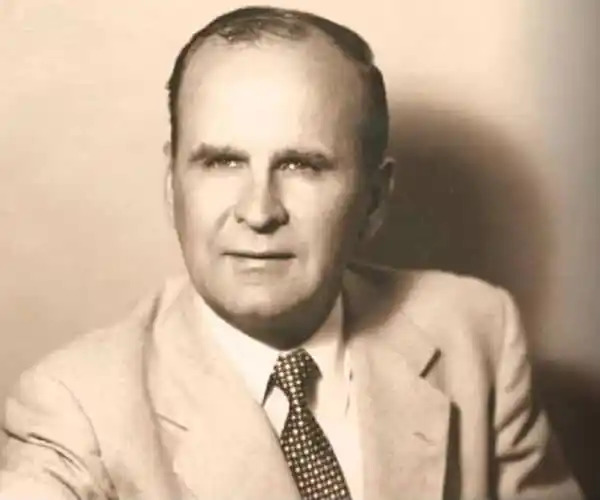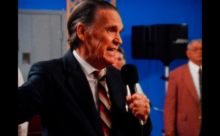Raise the Dead, William Marrion Braham by C. Douglas Weaver
Religious scholar C. Douglas Weaver's article on the ministry of William Marrion Branham
(First published in the study guide to the film Raise the Dead)
The post-World War II healing revival that erupted in American pentecostalism began in the ministry of William Marrion Branham, a “Holy Ghost” independent Baptist preacher from Jeffersonville, Indiana. In 1946, Branham claimed that an angel commissioned him to be a prophet with the message of divine healing for the world. For the next nine years, Branham conducted a healing ministry that only Oral Roberts could match. He ministered to packed tents throughout the country; miraculous healings were claimed by thousands and Time magazine, while a skeptic, reported his popularity. Branham was also the first post-war American healing evangelist to tour Europe.
The Pentecostal masses revered Branham’s legendary healing gifts, the ability to detect diseases by the vibration of his hand and the ability to discern the secrets of a person’s heart (usually identified as the Word of Knowledge in I Corinthians 12:8, but ,when other evangelists claimed the,gift, Branham insisted his gift was unique duplication of Jesus’ method of healing). The visions given through the second gift were infallible, according to Branham. The person who sought healing was to place faith in Christ the healer and to believe that Branham was God’s prophet who declared the healing. Still, Branham’s quiet humility and avoidance of doctrinal conflicts endeared him to the different Pentecostal subgroups. He modeled, for other evangelists, the method of holding citywide inter-evangelical tent meetings among Oneness and trinitarian Pentecostals.
Healing revivalism declined in the late 1950s. Successful evangelists transformed their ministries into a broader charismatic revivalism which gave greater emphasis to all the gifts of the Spirit. Branham did not readily adapt. During the peak revival years, his ministry flourished despite his seventh grade education, lack of sophistication and poor business acumen. When the revival fires began to wane, Branham experienced financial difficulty. Attempting to cope with declining popularity, he increasingly asserted “prophetic” dogmatic doctrinal revelations. These teachings, referred to as the “end-time message” of God, made Branham increasingly controversial in Pentecostal circles.
The “Message” consisted of several important “revelations.” Denominationalism was called the “mark of the beast” and believers were to “come out.” Branham advocated a “Jesus only” antitrinitarian position regarding the Godhead and baptism, views he had avoided during his heyday. A revelation that embarrassed many former admirers was the doctrine of the serpent’s seed. According to Branham, Eve and the man-like serpent had sexual intercourse and Cain was born. Consequently, every woman potentially carried the literal seed of the Devil. Branham’s constant warning to “modern Jezebels” who cut their hair, wore makeup and swam in public, was poorly received as the charismatic movement reached beyond traditional Pentecostalism and touched the broader American society of the 1960s.
The most controversial revelation dealt with the identity of the “end-time Laodicean church age prophet” whose “message” would prepare the elect Bride of Christ for the imminent rapture. Although Branham never claimed it directly, with the help of some devoted disciples, he clearly came to believe that he was this prophet. In the 1960s, he preached that Billy Graham had taken revival to the “nominal” church, Oral Roberts had done the same for Pentecostals, but like the biblical father of faith, Abraham, the name of the prophet of the last days had seven letters
As the “end-time” prophet, Branham and his followers yearned for an unparalleled ministry, a final gift to “speak the Word” and perform greater miracles than ever witnessed before. Branham believed this gift had been previewed several times, for instance, in the resurrection of a fish, the “creatio ex nihilo” of three squirrels and the calming of a Colorado blizzard by his command of “thus saith the Lord."
Branham died in an automobile accident in December, 1965. Persons who admired his healing ministry mourned his death. Some independent Pentecostal evangelists, including H. Richard Hall, of Cleveland, Tennessee, W. V. Grant, Jr., of Dallas, Texas, and Neal Frisby, of Phoenix Arizona, claimed Branham’s prophetic mantle. Many veterans of the healing revival were saddened that Branham had disobeyed his calling to a healing ministry and had become entangled in doctrinal heresy.
Branham’s devoted followers were shocked at his death. Some expected an Easter resurrection in the spring of 1966. Today “Message” believers exist in a variety of independent groups. An accurate estimate of committed followers is impossible, though 300,000, (or thousands more) worldwide adherents have been speculated. While beliefs differ, Branham is at minimum acknowledged as the “end-time prophet,” the Elijah figure of Malachi 4:5-6. A few churches have even deified him. Branham’s sermons have achieved scriptural status for most followers as the infallible “voice of God” to the Bride of Christ. “Voice of God” publishing in Jeffersonville, Indiana, is led by Branham’s son, Joseph, and sends tapes and written sermons, translated into several languages, throughout the world.
—C. Douglas Weaver

